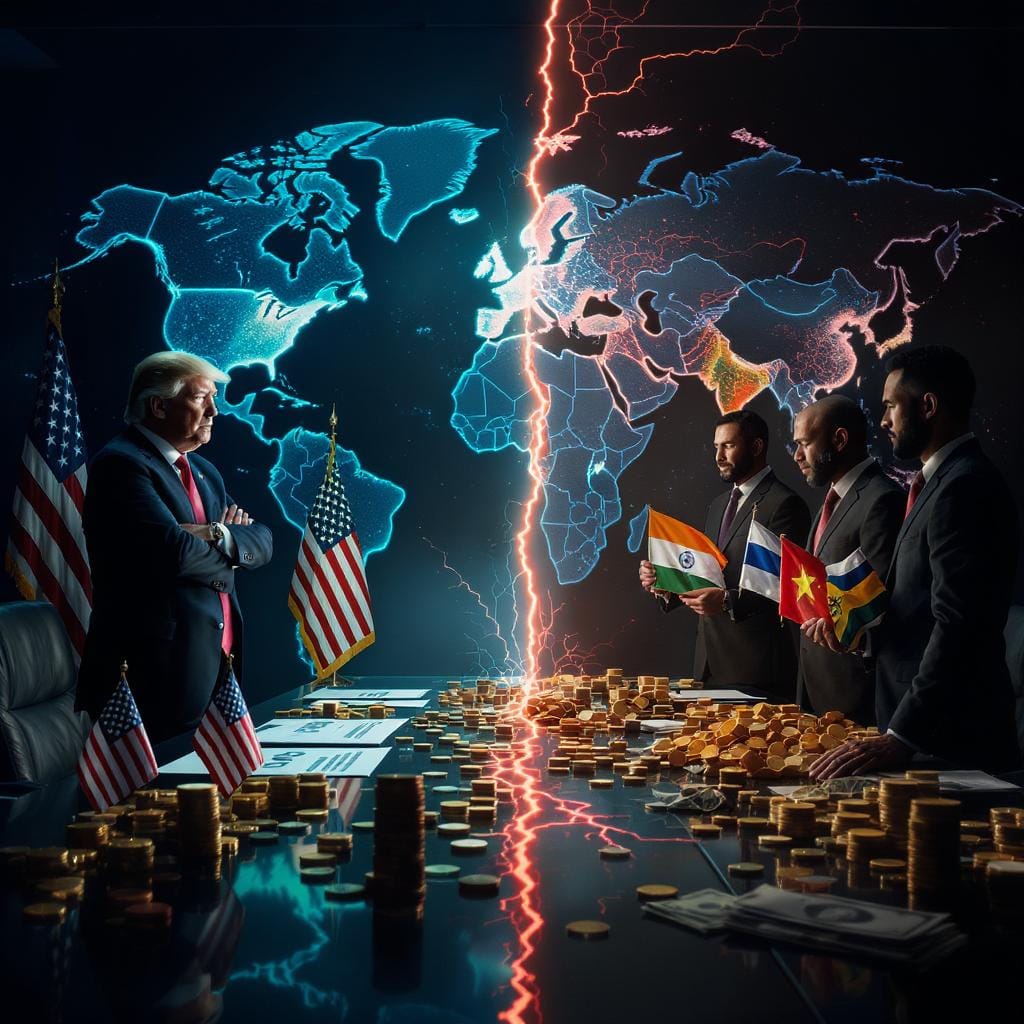Trump’s Tariff Escalation: Targeting BRICS Amid Global Trade Shifts
The landscape of international trade is undergoing a profound transformation in 2025, with the United States imposing new tariffs that specifically target the BRICS nations. This move builds on a broader framework of supply chain diversification efforts, particularly in countries like India, which has been actively pursuing policy shifts to reduce dependencies on dominant players such as China. The additional 10% tariff on BRICS countries not only addresses economic imbalances but also counters the bloc’s expanding influence in global trade and finance, including initiatives for de-dollarization and alternative payment systems.

As global supply chains face increasing disruptions from geopolitical tensions, nations are reevaluating their strategies. India’s approach exemplifies this trend, with recent policy measures aimed at fostering self-reliance and attracting foreign investment. These developments are timely, as the new U.S. tariffs could accelerate such shifts, prompting BRICS members to deepen intra-bloc cooperation while navigating higher costs in the American market.
The BRICS Summit as a Catalyst
The BRICS summit, which concluded in Rio de Janeiro on July 7, 2025, highlighted the bloc’s ambitions and vulnerabilities. Representing about 40% of global economic output and half the world’s population, the group discussed strategies to enhance economic resilience amid external pressures. Leaders condemned unilateral tariffs as disruptive to global supply chains, emphasizing the need for internal cohesion. This event directly influenced the U.S. response, with the tariff announcement appearing as a counter to discussions on reducing reliance on the U.S. dollar—a policy that had previously drawn warnings of even steeper levies.
The summit’s focus on trade promotion within the bloc underscores a shift toward multipolar economic systems. For instance, expanded membership now includes nations like Saudi Arabia, Iran, and Egypt, strengthening BRICS as an alternative to Western-led institutions. This growing assertiveness has positioned the group as a target for policies aimed at preserving U.S. economic dominance.
Why Target BRICS?
The BRICS alliance has evolved into a formidable force, challenging traditional power structures through initiatives that promote trade diversification and financial independence. The U.S. administration views certain policies—such as efforts to de-dollarize transactions or forge trade agreements bypassing American influence—as threats to its interests. While specifics remain broad, the tariffs signal an intent to deter actions that could undermine the dollar’s global role.
This targeting reflects a strategic pivot in U.S. trade policy, using economic tools to address perceived geopolitical risks. For BRICS nations, it means confronting barriers in a key export market, potentially redirecting flows toward emerging economies and accelerating the bloc’s internal integration.
The Tariff Threat in Detail
Announced on July 7, 2025, the new tariffs impose an additional 10% on goods from BRICS countries, layered atop existing or planned duties. Rates could range from 10% to 70%, with implementation set for August 1, 2025. Starting that week, letters were sent to 12 countries outlining specific rates, though details on exact targets are still emerging. The focus on BRICS suggests a deliberate effort to curb the bloc’s momentum.
These measures extend previous threats from late 2024, when 100% tariffs were floated in response to currency challenges against the dollar. The current approach is more calibrated, serving as leverage in negotiations while maintaining pressure on trade practices deemed unfair.
How Tariffs Impact Trade
Tariffs function as taxes on imports, elevating costs for foreign goods in the U.S. This can bolster domestic industries but often leads to higher prices for consumers and supply chain interruptions. For BRICS exports—like electronics from China, textiles from India, or agricultural products from Brazil—the added 10% could erode competitiveness, forcing companies to absorb costs or seek alternative markets.
In practice, such policies ripple through global networks, affecting everything from raw materials to finished products. Industries reliant on cross-border components, such as automotive and technology, face particular challenges, highlighting the interconnected nature of modern trade.
India’s Supply Chain Diversification: A Policy Shift in Action
India has emerged as a leader in supply chain diversification, implementing bold policy changes to mitigate risks from over-reliance on single sources. In recent months, the government has intensified efforts under initiatives like the Production Linked Incentive scheme, which incentivizes manufacturing in sectors such as electronics, semiconductors, and pharmaceuticals. As of July 2025, these policies have attracted major investments, with companies like Samsung and Apple expanding operations to produce for global markets, including the U.S.
A key development is India’s push for the “China Plus One” strategy, encouraging firms to diversify away from China amid ongoing trade tensions. Latest updates show progress in semiconductor fabrication, with the first indigenous facility on track for completion by year-end. Additionally, oil imports have shifted significantly, with the U.S. and Brazil becoming primary suppliers, reducing dependence on Middle Eastern sources and enhancing energy security.
The new 10% tariff on BRICS nations aligns with this framework by pressuring India to further decouple from vulnerable chains. In response, Indian businesses—about 48% according to recent surveys—are actively diversifying sourcing, supported by government negotiations for free trade agreements and retaliatory duties on select U.S. Commerce Minister Piyush Goyal has prioritized national interests, opting for measured responses while accelerating deals in critical areas. For example, tariff reductions on 90% of lines in ongoing talks could stabilize flows, while companies like Samsung prepare to route U.S.-bound products through Indian factories to evade higher levies.
These shifts not only buffer against tariffs but also position India as a beneficiary of global realignments, with manufacturing output expected to surge. Apple’s projected $22 billion in Indian production this year illustrates the scale, though challenges like labor dynamics persist. Overall, these policies foster resilience, catalyzing growth in a tariff-heavy environment.
Reactions from BRICS and the Wider World
BRICS members have responded with calls for solidarity, promoting intra-bloc trade to offset losses. Brazil, as a recent host, stressed cohesion, while India advocates caution in rushed deals. Beyond the group, reactions vary:
Vietnam secured a reduced rate of 20% through negotiations, down from 46%, highlighting the value of bilateral exemptions.
Singapore, despite its free trade agreement with the U.S., faces a 10% levy, prompting concerns over alliance strains.
The European Union seeks carve-outs for pharmaceuticals and semiconductors but has advanced little, underscoring broader negotiation difficulties.
These responses reveal a fragmented global stance, with some nations adapting swiftly and others bracing for impacts.
Economic and Political Ramifications
For the U.S., tariffs promise to protect jobs but carry downsides. Businesses with revenues between $10 million and $1 billion could incur $82.3 billion in costs, with 60% potentially passed to consumers, exacerbating inflation and complicating interest rate decisions.
BRICS economies, export-heavy, risk strains: India’s textiles and China’s electronics may see diminished demand, while Brazil’s agriculture competes harder. This could hasten de-dollarization, expanding alternative networks.
Globally, supply chains in electronics, textiles, and furniture stand disrupted, heightening risks for developing nations. Legal uncertainties, including a pending court ruling on tariff authority, add layers of complexity.
Looking Ahead: Negotiations and Outcomes
The 90-day negotiation window ends on July 9, 2025, paving the way for August 1 implementations. Only a handful of countries, like the UK and Vietnam, have mitigated effects through deals. The focus on BRICS indicates a geopolitical strategy, likely spurring the bloc’s independence efforts.
As tensions rise, nations must balance negotiations, legal hurdles, and economic fallout. The coming weeks will define whether these tariffs reshape trade or spark wider conflicts, with India’s diversification serving as a model for adaptation in an uncertain world.


